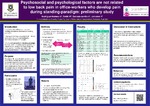Mostrar o rexistro simple do ítem
Psychosocial and psychological factors are not related to low back pain in office-workers who develop pain during standing-paradigm: preliminary study
| dc.contributor.author | Rodríguez-Romero, Beatriz | |
| dc.contributor.author | Smith, M. | |
| dc.contributor.author | Quintela-del-Río, Alejandro | |
| dc.contributor.author | Johnston, V. | |
| dc.date.accessioned | 2021-11-29T12:49:43Z | |
| dc.date.available | 2021-11-29T12:49:43Z | |
| dc.date.issued | 2019 | |
| dc.identifier.citation | Rodríguez-Romero B, Smith M, Quintela-del-Río A, Johnston V. Psychosocial and psychological factors are not related to low back pain in office-workers who develop pain during standing-paradigm: preliminary study. En: World Confederation for Physical Therapy Congress 2019, geneva 10-13 May [Internet]. London, UK: World Confederation for Physical Therapy; 2019. Disponible en: https://www.abstractstosubmit.com/wcpt2019/archive/#/viewer/abstract/2160 | es_ES |
| dc.identifier.uri | http://hdl.handle.net/2183/28982 | |
| dc.description | Poster | es_ES |
| dc.description.abstract | [Abstract] Background: Low back pain (LBP) is a common and disabling musculoskeletal disorder in the working population. Laboratory studies have indicated that prolonged standing is associated with LBP with the focus to date on understanding the biomechanical source of this pain. An induced-pain protocol (standing-paradigm) has been used to examine psychological factors in back-healthy people in previous studies, but none have examined the association with psychosocial factors in office workers. Purpose: To examine: 1) the relationship between group status (those who did and did not develop LBP during standing) and workplace psychosocial factors (Job Content Questionnaire, Job Satisfaction), and individual psychological factors (Pain Catastrophizing Scale, Mental Component Summary of SF-12); and 2) the relationship between intensity of LBP during standing and workplace psychosocial and individual psychological factors. Methods: A cross-sectional laboratory-based study was conducted. A convenience sample of 32 office-workers, who perform more than 30 hours per week mostly sitting at a computer were recruited. Participants completed their own work and rated their LBP intensity every 15 minutes during the one-hour standing-paradigm. The primary outcomes were: a) group status based on change in LBP score (measured on a 100-mm visual analogue scale (VAS); and b) change in LBP intensity during the standing-paradigm. Secondary outcome measures completed prior to the one-hour standing task were: four dimensions of the Job Content Questionnaire (JCQ); one question on Job Satisfaction; 3 dimensions of Pain Catastrophizing Scale (PCS) and PCS-total score; Mental Component Summary (MCS) of SF12. Demographic, anthropometric, physical activity levels (International Physical Activity Questionnaire), and previous episode of LBP (lifetime and last month) data was collected. Data analysis included independent group t-test (continuous variables) and Chi Square (categorical variables) to test for differences between PDs and NPDs at baseline. Pearson correlation coefficients were calculated for VAS and the scores on JCQ, Satisfaction Job, PCS and MCS. Logistic regression was performed to identify which factors were associated with group membership (PDs or NPDs) with JCQ, PCS and MCS as independent variables controlling for age, sex, BMI and history of LBP. Statistical significance was set at p ≤ 0.05. Results: There were 14 (43.8%) PDs. The mean maximum LBP reported by PDs was 26 mm (range 4 to 59 mm). There were no significant differences at baseline for age, BMI, and physical activity levels between the PDs vs NPDs and nor any significant differences between the groups for any workplace psychosocial or psychological measures. Correlations between VAS and each psychosocial and psychological measures were small and not significant. Regression modelling showed that sex (p=0.01), lifetime episode of LBP (p=0.04) and LBP-last month (p≤0.01) predicted PD status. Conclusion(s): These results suggest that in office-workers baseline psychosocial and psychological status do not differentiate who will develop LBP during standing. LBP intensity was not related to workplace psychosocial nor individual psychological status. Only sex and previous history of LBP identified those who developed LBP during the standing-paradigm. | es_ES |
| dc.language.iso | eng | es_ES |
| dc.publisher | World Confederation for Physical Therapy | es_ES |
| dc.relation.uri | https://www.abstractstosubmit.com/wcpt2019/archive/#/viewer/abstract/2160 | es_ES |
| dc.subject | Low back pain | es_ES |
| dc.subject | Office-workers | es_ES |
| dc.title | Psychosocial and psychological factors are not related to low back pain in office-workers who develop pain during standing-paradigm: preliminary study | es_ES |
| dc.type | info:eu-repo/semantics/conferenceObject | es_ES |
| dc.rights.access | info:eu-repo/semantics/openAccess | es_ES |
| UDC.conferenceTitle | World Confederation for Physical Therapy Congress 2019 | es_ES |






